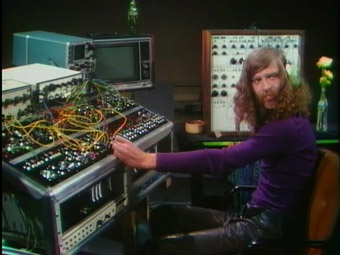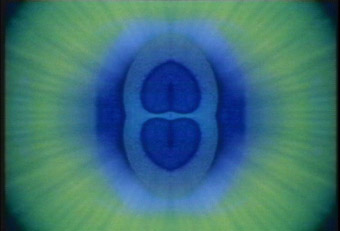sound-image synaesthesia
césar ustarroz: stephen beck, pioneering media artist

Stephen Beck
image courtesy the artist
Stephen Beck
A REVIEW OF THE ORIGINS OF VIDEO ART UNCOVERS A SIGNIFICANT, MULTIFACETED FIGURE, THE NORTH AMERICAN VIDEO ARTIST STEPHEN BECK, WHO DESERVES ACKNOWLEDGMENT FOR HIS CONTRIBUTION TO REAL-TIME AUDIOVISUAL PRODUCTION. THE CREATIVE PERSONALITY OF BECK’S WORK HAS TAKEN SHAPE IN VARIOUS FIELDS OF ARTISTIC EXPRESSION: VIDEO-SCULPTURE, INSTALLATION, MUSIC, PERFORMANCE, MUSIC VIDEO, VIDEOGAME DESIGN AND RESEARCH. THERE ARE NO DEFINITIVE BORDERLINES IN BECK’S WORK; HE EMPLOYS VIDEO AND OTHER TECHNOLOGIES TO TRANSLATE AND REPRESENT HIS SINGULAR EXPERIENCE.
Between 1969 and 1970, as an electronic artist in residence at the National Center for Experiments in Television (NCET) at KQED-TV in San Francisco, he developed the Beck Direct Video Synthesizer, an ingenious invention for the generation and manipulation of analogue images in real-time. With it he created a series of audiovisual performances, Illuminated Music, in 1972-73 before a live audience interpreting a musical piece previously recorded or conducted live, with the images displayed on television screens or by projectors. Performativity, spontaneity, ubiquity, the non-objective nature of the art work, its ephemeral quality and the immediacy of its representation highlighted the uniqueness of the work, translating the experience of the artist’s interiority into a non-verbal language with symbology and Eastern imagery. In Beck’s own words:
“I had the image come to me from listening to the music, and as I often do, much of my work in visual art and video is based on what I see with my mind’s eye, my eyes closed—inner imagery. I’ve seen inner imagery for as long as I can remember, even since I was a young boy—phosphenes, hypnogothic [sic], hypnopompic, eidetic, hallucination, meditation. So, as I would listen to the music and start to see certain visual elements I would notate them into the score for the visual composition.

Yoni Glow, Stephen Beck
image courtesy the artist
Yoni Glow, Stephen Beck
“Now, in each performance of Illuminated Music that followed over the next two years, if you looked at all six of them, you would see there is a similar structure. It begins with these tiny rotating particles, suggesting perhaps, subatomic particles or some kind of magnetic, gravitational, orbital, based on sine waves, and then it kind of expands into these waves of lines and lace, becoming from one dimension of a point to two dimensions of lines and weavings. Eventually, solid smooth orbs and spheres appear along with a final spiral vortex, symbolising the great energy of the cosmos as [it] has been exhibited in many cultural icons throughout history.”
Beck reorients non-objective art in Illuminated Music I and II through an extraordinary communion with the soundtrack, a creative ‘synthony’ that demonstrates the multidisciplinary character of the artist’s background, with its roots in electronic music (Beck studied with John Cage at the University of Illinois). In his work we can perceive music as an inspirational source, both in the execution of the audiovisual work in real-time, and in the later addition of the sound as a component that determines the meaning of the audiovisual message. The structure of his message, as Beck himself describes it, presents certain analogies with jazz: the presentation and development of a theme with variations. Beck uses a grammatical syntaxis that gains strength with improvisation, the reading and in situ interpretation of a musical piece: “…that was kind of my concept, wanting to try to create a form of visual jazz, that would flow in time like music but be visual, and also have a compositional structure that was formal and intact, but still allowed for variations in the way that it was played and performed.”
Beck’s vision has technology and art flow together in a fertile encounter. At the end of the 1960s, Gene Youngblood, in his book Expanded Cinema (1970), a seminal work that embraced video and computers, demonstrated a collaboration between engineers and artists that was already happening in west coast America. In the vein of Harry Smith, Jordan Belson and the Whitney brothers, in the work of Beck we can appreciate the creative side of the man-machine symbiosis. Technology is a tool at the service of artistic expression.
With the works Colour Music and Lumia, Beck’s intention was to achieve a synaesthetic union of sight and sound—which could be expressed as “painting the music.” By creating and manipulating form, colour, texture and movement, Beck introduced the embryonic electronic image in constructing an audiovisual discourse in real-time. Beck’s 25 frames per second contributed to the acceleration of the processes of interaction and participation in new media. He says, “At this point, in terms of real-time video performance, that was pre-digital era. There was no programming, there was no pre-recording (of video), it was played live on the synthesizer.
“Well, I always like to say that my art spans from pre-digital to post-digital. Pre-digital meaning the era that I started, the late 1960s, when for all practical purposes, there was not much available to video artists in digital computing that could do a dot—draw one monochrome dot on a screen. It would take hours to draw some more, they had to be filmed with stop action, such as John Whitney’s work, Arabesque. Post-digital, meaning the current era, is all pervasive. I still describe myself as live and analog, meaning I prefer the analog texture, the analog approach, even though of course, I’m using digital tools, fully and completely now like everyone else because of the ease, convenience, quality control.”
Another of Beck’s most celebrated video pieces is Voodoo Chile (1982), a music video with recorded music from Jimi Hendrix, where we cannot separate music from image. In making Voodoo Chile Beck mixed real time with video editing: “All the varieties of scenes that you see in Voodoo Chile, optical seeding, video synthesis, a lot of use of video feedback, analog fractals, which I had learned to control with special circuitry in my Beck Direct Video Synthesizer to obtain video feedback-type effects and energies that were unique. And they also had the rights to an image of Jimi Hendrix playing the guitar, but my concept for Voodoo Chile was to not show Jimi Hendrix playing the guitar, but to show a light show-like visual interpretation of his music. Not, you know, a definitive visual interpretation, but my visual interpretation.”
Almost four decades have passed and Noor (2005-09) is Beck’s most recent project. Ambitious and in constant development, Noor is a live organism where imagery and motifs from Eastern cultures come to life through abstract form and patterns, models of representation and expression, showing the richness of Beck’s cinematic speech. Working in his laboratory, leading the Noor project and teaching at the University of California at Berkeley, Beck still chooses experimentation as a way to structure his vision of culture with video as a medium. Lately, he is exploring the creative possibilities of digital tools, searching in the language of programming for new forms of representation. Noor is a metaphor for Beck’s primary concern: trying to decipher and explain the complex consciousness of a human being, translating it with images in movement. “To me, the goal of my art is to inspire…to reveal the beauty of life in a world that is often filled with ugliness and tragedy and darkness. So working with light, working with video, working with Noor is the latest form, the latest path, the latest method by which I hope and intend to realize this vision.”
This article is based on an interview with Stephen Beck, January 12, 2009, Berkeley, California for Ustarroz’s forthcoming book, Vj-ing Theory—Audiovisual Production and Representation in Real-Time, A Link to the Cinematic Avant-Garde of 20th Century. For more on Stephen Beck: www.stevebeck.tv
RealTime issue #93 Oct-Nov 2009 pg. 35






